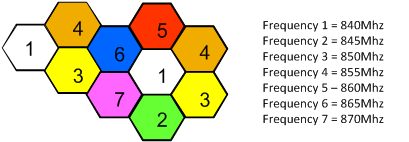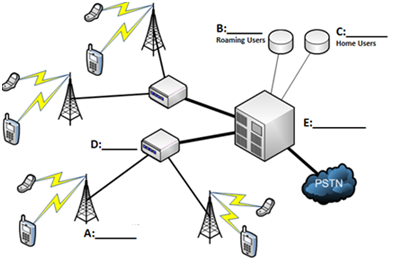YOU MUST INCLUDE UNITS OF MEASURE (miles, feet, dB, etc) for full credit.
Use the following Figure for questions 1 & 2

1. What type of interference occurs between the two white cells? _______________________________
2. How is the interference problem identified in problem 1 usually solved? Explain how you know if the solution is adequate to fix the problem caused by the interference.
3. Label the indicated architecture elements with the proper acronym.

4. Define the acronyms in question 3.
A. ____________________________________________
B. ____________________________________________
C. ____________________________________________
D. ____________________________________________
E. ____________________________________________
5. What is the primary function of the architecture element in question 4-A?
6. What is the primary function of the architecture element in question 4-B?
7. What is the primary function of the architecture element in question 4-C?
8. What is the primary function of the architecture element in question 4-D?
9. What is the primary function of the architecture element in question 4-E?
10. 2 mobile transmitters, A & B, are both operating on a frequency of 845.250Mhz with identical power and antenna systems and positioned 8 miles apart. The receiver is is positioned exactly halfway between the transmitters and is trying to receive a signal from Transmitter A. What must happen to reduce the interfering signal to 1/9th of its current level? Support your answer with appropriate calculations.
11. What is the formula to calculate C/I?
12. What is the C/I ratio of the system shown below system if the radius of coverage is 6 miles?
13. Is the C/I ratio in problem 12 sufficient under generally accepted design guidelines? Why or why not?
14. How large must the separation distance be for a system with eight unique frequencies and a radius of coverage of six miles?
15. How much, if any, does D if we decrease the cell radius to three miles in question 14? Why?
16. What is the complete term for the unique identifier of the physical mobile phone?
17. What is the complete term for the unique identifier of a particular cellular network?
18. A network study of the peak busy hour shows that Redneck Cellular has 4000 subscribers who make 5 calls per hour that last an average of 8 minutes. It has 2000 subscribers who make 2 calls per hour that last 3 minutes while 1500 of the subscribers make 9 calls per hour that last 45 seconds. What is the offered traffic?
19. What is 16.75 Erlangs expressed in MOUs?
20. What is 121CCS expressed in Erlangs?